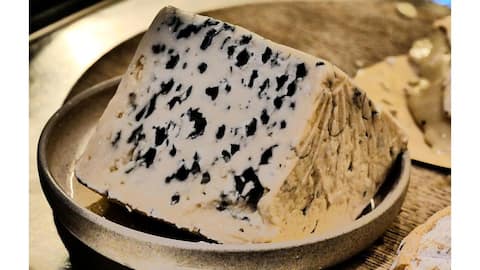Discovering the wonders of blue cheese
What's the story
Blue cheese, with its striking appearance and distinctive flavor, holds a special place in the hearts of cheese enthusiasts worldwide. Beyond its unique and bold flavor, blue cheese boasts a rich history and a diversity of fascinating facts that contribute to its popularity. Let us delve into some facts about this variety of cheese and why it is so uniquely captivating.
About color
Distinct blue-green veins
The distinct blue or blue-green veins on the cheese are created by the introduction of mold cultures, typically Penicillium roqueforti or Penicillium glaucum. These molds grow within the cheese during the aging process, imparting a tangy flavor and creamy texture. Blue cheese varieties can vary widely in taste and texture, but they generally have a pungent aroma and a complex, savory flavor profile.
In culture
Cheese tradition
Roquefort, crafted from raw sheep's milk, is celebrated in France as one of the country's most iconic cheeses. In England, Stilton is granted a protected designation of origin status, ensuring that only cheese produced in specific regions and according to traditional methods can bear the name. Similarly, Denmark's esteemed blue cheese tradition with Danish blue is known for its milder flavor and crumbly texture.
Robust aroma
Diversity
The hallmark of blue cheese lies not only in its distinct appearance but also in its robust aroma, setting it apart from other varieties. This aromatic intensity and salty flavor profile defines blue cheese. What truly makes this cheese remarkable is its diversity. No two blue cheeses are identical, offering an exciting array of flavors and textures to explore.
Origin
A serendipity
In ancient times, in a village in France, there was a shepherd who forgot his lunch of bread and cheese in a cave. When he returned many months later, he found that the cheese had changed. It had blue veins running through it, caused by mold that grew in the cave. This accident led to the creation of blue cheese, which became popular worldwide.
How it is made
Oxygen is key
Today, blue cheese production has been refined, with the natural mold added directly to the cheese milk. To encourage the blue veins, the cheese is pierced with needles or skewers to allow oxygen inside. This oxygen triggers the growth of the mold, which matures within the cheese, infusing it with flavor over three to six months.
How it is served
Assortment of flavors
One of the most delightful ways to enjoy blue cheese is to pair it with an assortment of complementary flavors. Serve it alongside salty crackers, fresh figs, and roasted almonds for a great balance of texture and taste. It can be crumbled upon salads, and pies or mushrooms filled with a mixture of cream cheese, garlic, herbs, and crumbled blue cheese.
Caution
Proper storage
Exposure of blue cheese to improper storage conditions, such as prolonged periods at room temperature or extended refrigeration without consumption, can result in spoilage. This can lead to the development of mycotoxins by the mold present in the cheese. Consumption of such contaminated cheese can potentially cause adverse health effects, highlighting the importance of proper storage and its timely consumption.
